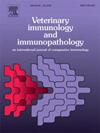一种diva兼容的牛分枝杆菌三突变疫苗在小鼠模型中对牛结核病具有保护作用
IF 1.4
3区 农林科学
Q4 IMMUNOLOGY
引用次数: 0
摘要
牛结核病(bTB)是一种由牛分枝杆菌引起的肺部传染病,影响牛和包括人类在内的多种哺乳动物。尽管它对全球畜牧业生产产生重大影响,但目前还没有商用疫苗,部分原因是标准诊断测试可能受到干扰。在这项研究中,我们评估了缺乏免疫优势抗原ESAT-6和CFP-10以及毒力因子Ag85A的三种牛分枝杆菌突变体的保护效果。该突变体与基于ESAT-6和CFP-10检测的DIVA(受感染动物与接种动物的区分)诊断兼容。利用重组Ag85A偶联壳聚糖纳米胶囊对三突变体进行了单独和异源启动-增强方案的检测。通过对肺部和脾脏中的牛支原体集落形成单位(cfu)进行量化来评估保护作用。在固体培养基上培养器官匀浆,并在镀后5周和10周枚举cfu。在五周时,所有接种组的肺部都显示出相当的保护作用。在脾脏中,与未接种疫苗组相比,三重突变组和卡介苗组均显示CFU计数减少。到第10周时,肺保护在初始强化组和卡介苗组最为明显,而脾脏保护仅限于初始强化组。在这个阶段,在肺和脾脏中检测到三重突变体的持久性,强调需要进一步评估其残留毒力。通过测量CD4 +KLRG1-CXCL3 + T细胞(先前与结核病保护性免疫相关的一个亚群)和其他评估的T细胞群来评估攻击后免疫应答。与未接种疫苗的对照组相比,接种疫苗的小鼠表现出显著的种群扩张。值得注意的是,这些细胞的高频率与肺部细菌负荷的减少相关,增强了它们作为保护性免疫生物标志物的潜力。本文章由计算机程序翻译,如有差异,请以英文原文为准。
A DIVA-compatible Mycobacterium bovis triple mutant vaccine confers protection against bovine tuberculosis in mouse model
Bovine tuberculosis (bTB) is a pulmonary infectious disease caused by Mycobacterium bovis, affecting cattle and a wide range of mammals, including humans. Despite its significant impact on global livestock production, no commercial vaccine is currently available, partly due to potential interference with standard diagnostic tests. In this study, we evaluated the protective efficacy of a triple M. bovis mutant lacking the immunodominant antigens ESAT-6 and CFP-10, as well as the virulence factor Ag85A. This mutant is compatible with DIVA (Differentiation of Infected from Vaccinated Animals) diagnostics based on ESAT-6 and CFP-10 detection. The triple mutant was assayed both alone and in a heterologous prime-boost regimen using recombinant Ag85A conjugated to chitosan nanocapsules. Protection was assessed by quantifying M. bovis colony-forming units (CFUs) in the lungs and spleen following challenge. Organ homogenates were cultured on solid media, and CFUs were enumerated at five and ten weeks post-plating. At five weeks, all vaccinated groups demonstrated comparable protection in the lungs. In the spleen, both the triple mutant and BCG groups showed reduced CFU counts compared to the unvaccinated group. By ten weeks, lung protection was most pronounced in the prime-boost and BCG groups, whereas spleen protection was restricted to the prime-boost group. At this stage, persistence of the triple mutant was detected in both lungs and spleen, highlighting the need for further evaluation of its residual virulence. Post-challenge immune responses were assessed by measuring CD4 +KLRG1-CXCL3 + T cells, a subset previously associated with protective immunity against tuberculosis, among other T cell populations evaluated. Vaccinated mice exhibited a significant expansion of this population compared to unvaccinated controls. Notably, higher frequencies of these cells correlated with reduced pulmonary bacterial burden, reinforcing their potential as a biomarker of protective immunity.
求助全文
通过发布文献求助,成功后即可免费获取论文全文。
去求助
来源期刊
CiteScore
3.40
自引率
5.60%
发文量
79
审稿时长
70 days
期刊介绍:
The journal reports basic, comparative and clinical immunology as they pertain to the animal species designated here: livestock, poultry, and fish species that are major food animals and companion animals such as cats, dogs, horses and camels, and wildlife species that act as reservoirs for food, companion or human infectious diseases, or as models for human disease.
Rodent models of infectious diseases that are of importance in the animal species indicated above,when the disease requires a level of containment that is not readily available for larger animal experimentation (ABSL3), will be considered. Papers on rabbits, lizards, guinea pigs, badgers, armadillos, elephants, antelope, and buffalo will be reviewed if the research advances our fundamental understanding of immunology, or if they act as a reservoir of infectious disease for the primary animal species designated above, or for humans. Manuscripts employing other species will be reviewed if justified as fitting into the categories above.
The following topics are appropriate: biology of cells and mechanisms of the immune system, immunochemistry, immunodeficiencies, immunodiagnosis, immunogenetics, immunopathology, immunology of infectious disease and tumors, immunoprophylaxis including vaccine development and delivery, immunological aspects of pregnancy including passive immunity, autoimmuity, neuroimmunology, and transplanatation immunology. Manuscripts that describe new genes and development of tools such as monoclonal antibodies are also of interest when part of a larger biological study. Studies employing extracts or constituents (plant extracts, feed additives or microbiome) must be sufficiently defined to be reproduced in other laboratories and also provide evidence for possible mechanisms and not simply show an effect on the immune system.

 求助内容:
求助内容: 应助结果提醒方式:
应助结果提醒方式:


